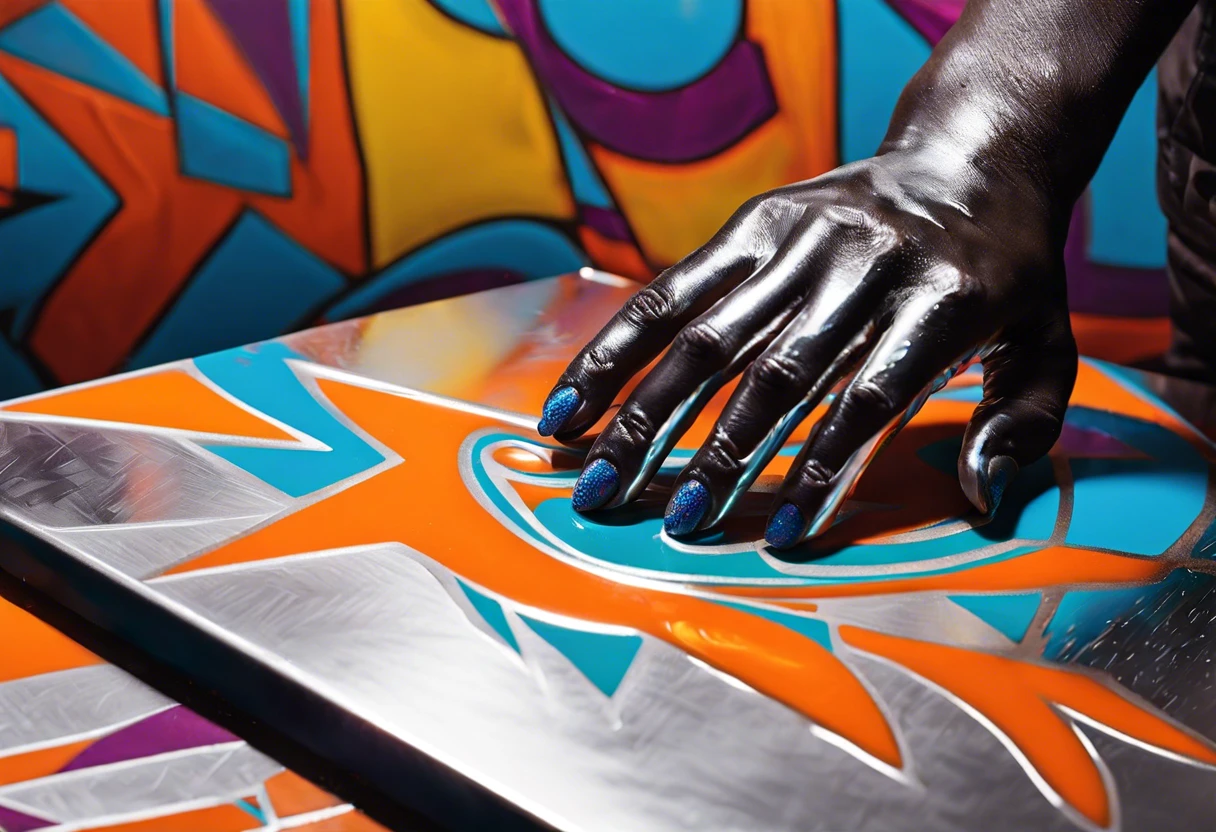Can You Paint Aluminum?
Published on: March 12, 2025 | Last Updated: January 7, 2025
Written By: Sarah McClintock
Aluminum is a shiny metal that’s super light and handy for all sorts of stuff. It’s like the superhero of materials, used for cans, cars, and even airplanes!
So, can you paint aluminum? It’s crucial to know because painting it wrong can lead to flaking or peeling over time. I’ve learned the hard way that using the right prep and paint makes a big difference in how long the finish lasts.
In this article, we’ll cover what aluminum is, the prep steps before you start, successful painting techniques, recommended colors, types of aluminum paints, factors affecting the process, common issues, finishing touches, and some creative DIY project ideas. Plus, I’ll touch on how to clean oil-based paint brushes and dispose of latex paint safely.
Contents
- 1 Can You Paint Aluminum?
- 2 What is Aluminum?
- 3 Preparation Steps Before You Start Painting Aluminum
- 4 Steps to Successfully Paint Aluminum
- 5 Different Types Of Aluminum Paints and Their Uses
- 6 Understanding Different Aluminum Finishing Techniques
- 7 Factors Affecting the Painting Process Of Aluminum
- 8 Understanding the Lifespan of Aluminum Paint
- 9 Common Misconceptions About Painting Aluminum
- 10 Common Issues You Might Encounter When Painting Aluminum
- 11 Adding Finishing Touches to Your Aluminum Projects
- 12 Creative DIY Project Ideas Using Painted Aluminum
- 13 Frequently Asked Questions About Painting Aluminum
- 14 Conclusion
- 15 Useful Resources
Can You Paint Aluminum?
Yes, you can paint aluminum. To do this, clean the surface well, use a primer designed for metal, and choose paint suitable for aluminum. This helps the paint stick better and lasts longer. If you’re working specifically with 8020 aluminum, you’ll want to follow some specialized painting techniques for aluminum surfaces. Easy, right?
What is Aluminum?
Aluminum is a lightweight, silvery-white metal known for its malleability and conductivity. It’s the most abundant metal in the Earth’s crust, making up about 8.1% by weight, with an atomic number of 13.
Can you paint aluminum? When I painted a set of aluminum chairs for my patio, I found that preparation makes a difference. A solid primer is key before applying the topcoat.
A friend asked for help with a DIY project at home. They chose aluminum frames for their modern art piece and later realized they needed to know how to clean oil-based paint brushes after finishing. To avoid messy brushes next time, it’s smart to have a plan for proper maintenance and disposal at the end of your paint project.
Preparation Steps Before You Start Painting Aluminum
What do you need to start?
- Aluminum Cleaner: You’ll need a cleaner like Simple Green Marine Cleaner. It removes grease and prepares the surface.
- Sanding Block: Use a sanding block, such as 3M Sandpaper 220-grit. It smooths the aluminum for better paint adhesion.
- Primer: Get an aluminum primer, like Rust-Oleum Aluminum Primer. It helps the paint stick and prevents corrosion.
- Spray Paint: Use a suitable spray paint, such as Valspar Anti-Rust Spray Paint. It’s designed for metal surfaces for a durable finish.
So far we covered the necessary preparation steps for painting aluminum. Let’s look at the steps for successfully painting aluminum next.
Also See: Can You Paint Copper? Transform It Easily

Steps to Successfully Paint Aluminum
Here are the steps to refine your aluminum surface for painting. Follow them all for a great finish.
-
Clean the Aluminum Surface
Start by cleaning the aluminum with a strong degreaser. Remove any dirt, grease, or oxidation to prepare the surface; a simple mix of water and dish soap works well.
For tough stains, use a mix of water and vinegar (1:1 Ratio). Rinse thoroughly and let it dry completely before proceeding.
-
Sand the Surface
Sand the aluminum using medium-grit sandpaper (About 180 Grit). This creates texture, allowing for better primer and paint adhesion.
I prefer wet sanding; it reduces dust and achieves a smoother surface. Wipe away the dust with a cloth after sanding.
-
Apply Aluminum-specific Primer
Choose a high-quality primer made for non-ferrous metals. This adds an extra layer of adhesion and prevents peeling.
I recommend using an etching primer; it chemically bonds with the aluminum. Apply a thin, even coat, and wait for it to dry according to the product instructions (Typically 30-60 Minutes).
-
Choose the Right Paint for Aluminum
Select paint specifically formulated for metals; enamel or acrylic paint works well on aluminum. Check the label for compatibility to ensure a solid finish.
Consider the item’s environment. For outdoor use, choose UV-resistant paint for better longevity.
-
Apply Paint in Thin Coats
Use a fine brush or spray can for even coverage. Always work in thin, light layers—this prevents drips and promotes a professional-looking finish.
Wait at least 24 hours between coats, but check the paint label for specific drying times. Two to three thin coats often yield a striking and durable color.
You should now have a good understanding of effectively painting aluminum surfaces. In the next part, we’ll discuss various aluminum paint types and their applications.
Different Types Of Aluminum Paints and Their Uses
Let’s explore the different types of aluminum paints: Acrylic, Enamel, Epoxy, and Alkyd.
-
Acrylic Paint
Acrylic paint is water-based, quick-drying, and easy to clean. It’s ideal for outdoor aluminum surfaces due to its good UV resistance and flexibility with temperature changes.
-
Enamel Paint
Enamel paint is great for aluminum because it creates a hard, glossy finish. It offers strong adhesion and withstands weather exposure, making it perfect for metal objects.
-
Epoxy Paint
Epoxy paint is very durable and provides excellent chemical resistance. This type is ideal for aluminum parts that face harsh conditions and need long-lasting protection.
-
Alkyd Paint
Alkyd paint is oil-based, providing a smooth finish and good adhesion on aluminum. It cures slowly for a crisp look, but cleaning brushes requires special solvents.
In my experience, acrylic paint is my preferred choice for outdoor aluminum projects. It dries quickly, is easier to work with, and performs well against the elements.
We’ve wrapped up various aluminum paint types and their applications here. Let us turn our attention to aluminum finishing techniques.
Understanding Different Aluminum Finishing Techniques
Different finishing techniques can greatly enhance the look and durability of your painted aluminum projects. Here are a few methods to consider:
Powder Coating
Powder coating is a popular finish for aluminum. It involves applying a dry powder that’s then baked in an oven. This process creates a tough, durable layer that resists chipping and fading. It’s especially effective for outdoor items. However, like any surface treatment, powder coating can experience wear over time, which is why understanding paint oxidation mechanisms matters.
Brushed Finish
A brushed finish adds a textured appearance by creating fine scratches on the aluminum surface. It’s done using a fine brush or abrasive pads, giving a sleek look while improving the paint’s adherence.
Anodizing
Anodizing involves electrochemically treating aluminum to create a thicker oxide layer. This process not only adds color but also enhances corrosion resistance. It can be a great alternative to painting.
Hydrographics
Hydrographics is a fun way to transfer complex patterns onto aluminum surfaces. You can achieve various designs with this technique—like wood grain or camo—without any paint peeling or flaking off.
| Finishing Technique | Durability | Best Use Cases |
|---|---|---|
| Powder Coating | Very High | Outdoor furniture, industrial applications |
| Brushed Finish | High | Modern decor pieces, art projects |
| Anodizing | High | Electronics, kitchenware |
| Hydrographics | Moderate | Custom designs, hobby projects |
That covers various aluminum finishing techniques. Let’s now take a look at the factors influencing the aluminum painting process.

Factors Affecting the Painting Process Of Aluminum
What factors influence successful painting of aluminum surfaces?
-
Surface Preparation: Not cleaning the aluminum can lead to poor paint adhesion.
-
Type of Paint: Using the wrong paint can cause peeling or chipping over time.
-
Environmental Conditions: Humidity and temperature significantly affect drying times and paint performance.
-
Primer Choice: Skipping the right primer can lead to poor reactions between the paint and aluminum.
Understanding the Lifespan of Aluminum Paint
Ever wondered how long your painted aluminum pieces will last? Let’s break it down!
| Type of Paint | Average Lifespan | Factors Influencing Lifespan |
|---|---|---|
| Acrylic Paint | 5-7 Years | UV exposure, humidity |
| Enamel Paint | 8-10 Years | Weather conditions, surface prep |
| Epoxy Paint | 10-15 Years | Harsh environments, maintenance |
| Alkyd Paint | 6-8 Years | Moisture, temperature changes |
The type of paint you choose directly impacts longevity. For example, epoxy paint holds up really well in tough conditions, lasting about 10 to 15 years. On the flip side, acrylic paint, while easy to work with, typically lasts around 5 to 7 years. So, what’s your project? Consider the conditions your aluminum will face!
Common Misconceptions About Painting Aluminum
Let’s set the record straight on some common myths about painting aluminum.
- Myth: You can’t paint over anodized aluminum.
- Fact: You can, but it requires sanding and a good primer for proper adhesion.
- Myth: Any paint will work on aluminum.
- Fact: No, use specialized paints for metal to avoid peeling and flaking.
- Myth: Painting aluminum is unnecessary; it doesn’t corrode.
- Fact: While aluminum resists rust, paint protects it from scratches and wear.
By debunking these myths, you can approach your aluminum projects with confidence and clarity. What other misconceptions have you heard? Let’s keep the facts straight!
Common Issues You Might Encounter When Painting Aluminum
When my friend tried to paint his aluminum patio furniture, the paint didn’t stick due to oxidation on the surface, which caused adhesion issues.
He fixed it by using a degreaser and sanding at 180 grit (0.18 Mm) to prepare the aluminum. A quality primer designed for metals resolved the adhesion problem.
Adding Finishing Touches to Your Aluminum Projects
After handling aluminum surfaces, apply a UV protectant. Choose products with at least 15% solids content. Reapply every 3-6 months for best results.
Inspect your aluminum for bubbles or cracks before sealing. Use a magnifying glass to check for damages smaller than 0.5 mm. I recommend Rust-Oleum’s metal paint for a reliable finish.
I suggest using a specialized scratch-resistant clear coat. This coat increases durability, withstands temperatures up to 120 °C (248 °F), and enhances metal adhesion for long-lasting protection.
Creative DIY Project Ideas Using Painted Aluminum
Ever thought about turning those plain aluminum cans into funky garden lanterns? Or maybe create colorful wall art with aluminum shapes and paint!
For the lanterns, just clean the cans and use a hammer and nail to punch holes. Grab some spray paint – you might spend around $10 (USD) and an hour or two to create some stunning pieces for your patio.
As for alternatives, you can explore using aluminum foil for an easy-to-paint project. Cut it into shapes and stick it onto canvases – the shine and textures create very cool effects. Trust me, once started, you’ll find aluminum’s potential crafty charm is limitless! Artists like Bob Ross pioneered creative techniques that inspire unconventional art approaches.
Frequently Asked Questions About Painting Aluminum
Now let us look at some of the questions I typically get asked about painting aluminum.
Can I Use Regular Paint on Aluminum?
No, you can’t use regular paint on aluminum. Specialized paints contain specific properties that adhere to aluminum surfaces and resist rusting. Ordinary paint can peel or chip, needing frequent touch-ups. If you’re curious about painting different materials, you might want to explore painting techniques for various surfaces.
How Do I Prepare Aluminum for Painting?
You need to clean and roughen aluminum before painting it. Start by washing with soap and water, then use a fine sandpaper (Around 240 Grit) to create a textured surface. This step improves the adhesion of the primer and paint. If you’re considering alternative surfaces like glass, you might want to explore painting techniques for glass materials.
What Type Of Primer is Best for Aluminum?
An etching primer is best for aluminum. Etching primers contain acids that create a bond and help paint adhere securely. This ensures better durability and a longer-lasting finish on the aluminum surface.
Can I Paint Anodized Aluminum?
Yes, you can paint anodized aluminum, but it requires special prep. Anodized surfaces are smooth, so sanding them lightens the coating and allows better adhesion of the paint. Always use a suitable primer afterward. If you’re curious about alternative painting techniques like using acrylic paint creatively, there are some interesting methods to explore.
How Long Will the Paint Last on Aluminum?
The paint can last 5 to 10 years on aluminum when properly applied. Factors like paint quality, environmental conditions, and surface preparation will affect the lifespan. High-quality paints resist fading and oxidation, extending durability.
How Do I Touch Up Paint on Aluminum Surfaces?
You can touch up paint on aluminum surfaces easily. Use the same color and type of paint, and clean the area first. Allow it to dry properly to blend in with the existing paint, avoiding an uneven appearance. If you’re considering using acrylic paint for fabric projects, you might want to explore painting material techniques.
Is There a Specific Temperature for Painting Aluminum?
Yes, the ideal temperature for painting aluminum is between 10°C and 30°C (50°F and 86°F). Paint adheres better when conditions are mild, reducing the chance of issues like bubbling or poor curing.
How Often Should I Repaint Aluminum?
You should repaint aluminum every 5 to 10 years, depending on wear and exposure. Regular maintenance keeps it looking fresh and can help prevent long-term damage catering to our climate and environment. If you’re considering painting other surfaces like brick, you might want to explore painting techniques for brick surfaces.
Conclusion
I’m glad we could cover this together. We discussed what aluminum is, preparation steps, successful painting methods, recommended color palettes, different types of aluminum paints, factors affecting the painting process, common issues, finishing touches, and creative DIY ideas.
It’s reassuring to know that you can definitely paint aluminum surfaces effectively with the right preparation and paint. By applying the methods we discussed—such as cleaning, priming, and selecting the ideal color—you’ll achieve excellent results.
For additional insights and tips, be sure to check out Paint Answers.
Useful Resources
- Betti, C., & Sale, T. (2012). Drawing: A Contemporary Approach (6th ed.). Belmont, CA: Cengage Learning.
- Paint Aluminum : 5 Steps (with Pictures) – Instructables




